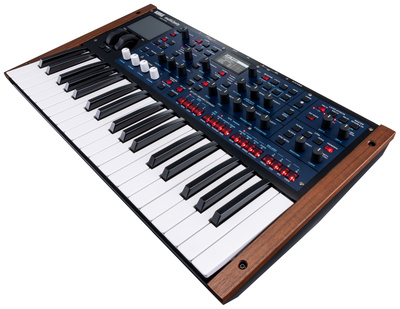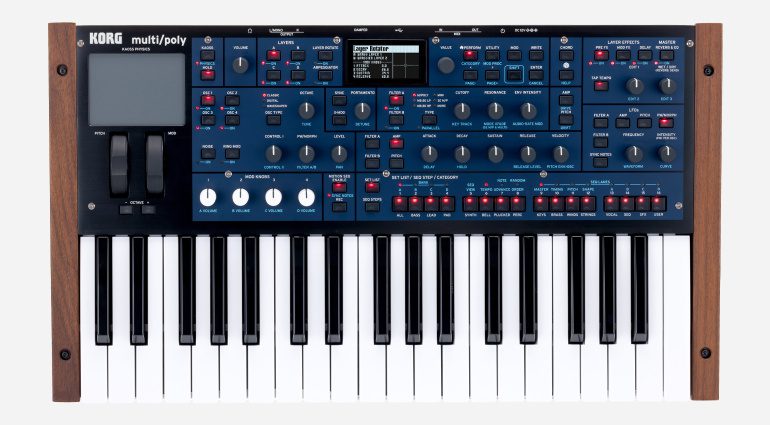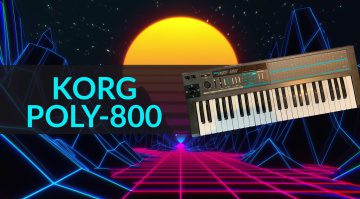KORG multi/poly: It’s Not What You Think. Or Is It?
A blast from the past gets a 21st century shot in the arm
KORG continues its line of Raspberry Pi-based synths by resurrecting a familiar name from the past with a twist. Let’s say hello to the new KORG multi/poly.
When KORG launched their range of synths based on a Raspberry Pi Compute board a few years back, they couldn’t have realised how much of a hit they had on their hands. Despite a few minor shortcomings, the synth engines really hit the spot and the platform thrives to this day.
Each synth, built into an almost identikit chassis, harked back to previous KORG synths of the 1980s and, most importantly, added new functionality not possible back in the day. The wavestate, modwave and opsix spawned (eventually) desktop, rack-mountable modules and the wavestate and opsix got full-size, 61-key SE versions.

The KORG multi/poly
Now KORG have added a new instrument to the range and it too calls back to KORG’s rich and successful history. The KORG multi/poly is a 2020’s spin on the mono/poly, both in terms of sounds and looks, but it is oh-so-much more than that.
We can’t avoid beginning with the looks. Blue faceplate, wooden end cheeks… there’s no mistaking its lineage. But what’s that above the pitch bend and mod wheels? Why, it’s a KAOSS pad! Does that give us a clue as to what’s under the hood, given that the modwave had one too? Yes, it still has 37 keys, which may annoy some people, but they are semi-weighted and are velocity and release-velocity sensitive. No aftertouch, though.
So Much More Than Analog
You’d be right because the four oscillators can either be “classic” virtual analog or digital wavetables. That’s a tantalising combination of sound generation sources which becomes even more exciting by the addition of dual filters that feature recreations of the original Mono/Poly, MS-20, Mini and Pro.
Those last two filter choices are recreations of classic filters from other innovative manufacturers of yore. The clues as to which are in the names!

The multi/poly is KORG’s first instrument to use their next-generation analog modelling technology, and if it is anything to go by, the future of KORG VA synths is looking and sounding very bright indeed. Its blending of VA, wavetables and waveshaping means that almost anything is sonically possible.
Each voice employs a ‘Virtual Voice Card’. Each card’s oscillators, filters, envelopes, LFOs and portamento circuits model analog hardware variations, which means that each voice has a slight difference in character. This variation can be controlled by the end user, so use as much or as little as you like.
With four oscillators per program, each able to use any of the three oscillator types, you can imagine the sonic possibilities the KORG multi/poly can create. There’s also a separate noise generator with its own filtering and saturation.
Modulation functions are in abundance too. There’s flexible routing options for things like ring and cross-modulation and oscillator sync, five LFOs, six modulation processors and four, yes FOUR DAHDSR envelopes! You can also stack up to four programs to create layers, splits and layer-rotate performances.
Comprehensive Effects
All of this can be passed through three FX blocks with a range of multi-effects, a master reverb and a master EQ. There’s also Motion Sequencing 2.0, KAOSS Physics via the pad, four programmable MOD controls and an arpeggiator. Maximum polyphony is a whopping 60 voices!
Users have the ability to import their own wavetables in standard formats and, just like the other Pi-based synths, there’s a dedicated editor/librarian application for Mac & PC. Connectivity includes line and headphone outs, pedal inputs, 5-pin MIDI and USB-B and the unit comes with its own PSU and soft case!

More Information
KORG continues to surprise us with these space-saving synths, and one can’t help but think that this may be a response to a certain Teutonic/Chinese company’s spin on its legacy. The KORG multi/poly is not just a revamped Mono/Poly. it’s way more than that. It also omits aftertouch like its earlier siblings, which begs the question: will there be an SE version in 2025?
Chances are there will, along with a module and almost certainly a software version. But what we do know is that if the previous examples are anything to go by, these will likely sell by the bucket load.
I spent a good number of hours scouring through the multi/poly specs and I could have written three times as much as I have here. KORG’s R&D team have really and literally pulled all the stops out on this one. If you were impressed by their previous Pi-based efforts, the multi/poly will blow your mind.
The KORG multi/poly is available to order now for just €939.00.


*This post contains affiliate links and/or widgets. When you buy a product via our affiliate partner, we receive a small commission that helps support what we do. Don’t worry, you pay the same price. Thanks for your support!
2 responses to “KORG multi/poly: It’s Not What You Think. Or Is It?”

 4,6 / 5,0 |
4,6 / 5,0 | 























Nice!
wish list – a longer keyboard version with poly aftertouch , a larger screen (maybe the next korg workstation will have this and some of.the other similar pi based synths built.in, with the ability to add more according to budget etc), and more outputs to take advantage of the multi parts.
C’mon KORG, just wack out the desktop/rack so those of us who plays in realtime can choose our way of integration without having 3 useless octaves sitting in the way!